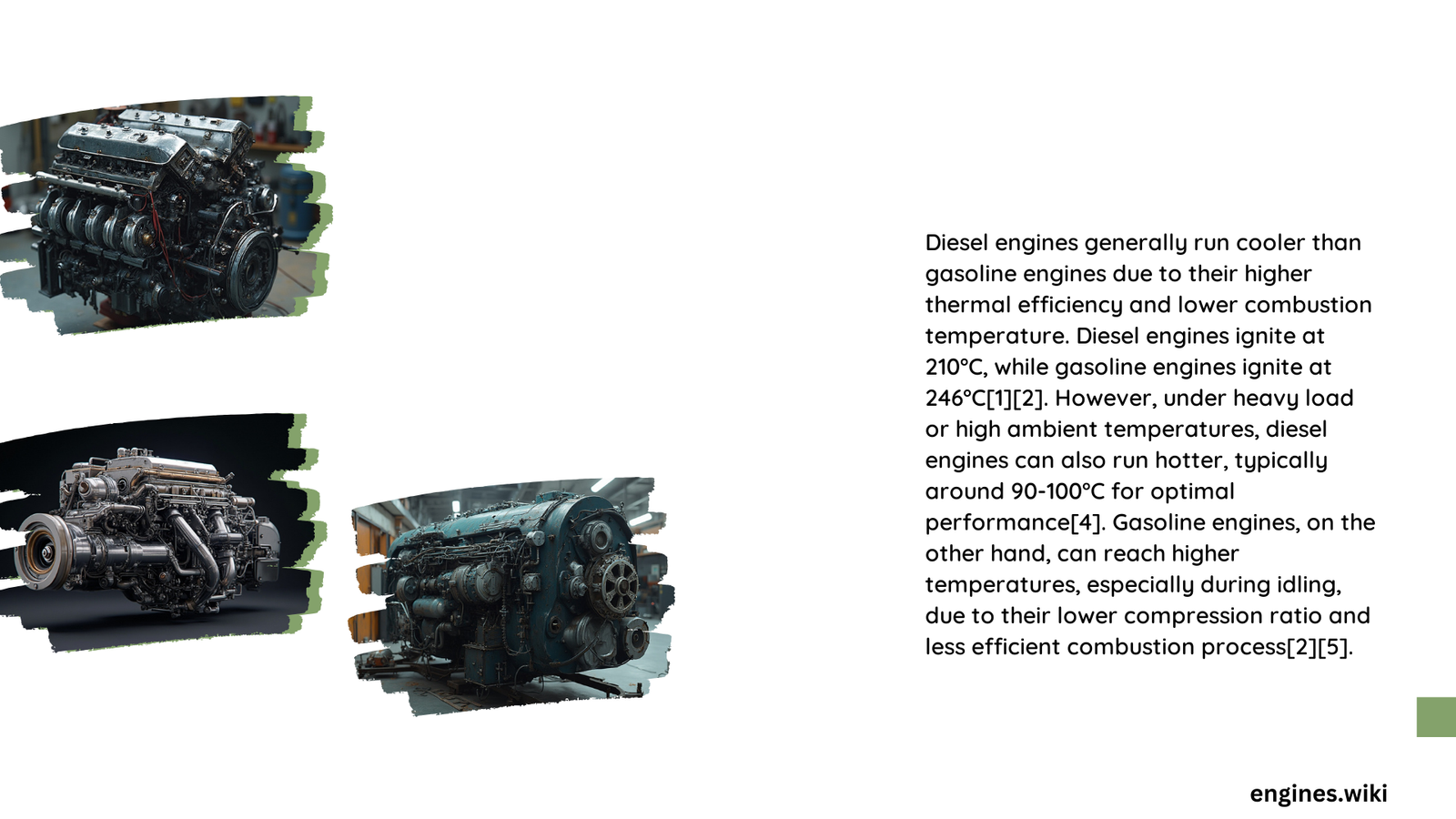Gas engines typically operate at lower temperatures than diesel engines due to differences in their combustion processes and design. While gas engines usually run with thermostats set around 180-200°F (82-93°C), diesel engines often operate at higher temperatures of 200-210°F (93-99°C). This temperature difference is primarily due to the higher compression ratios and combustion temperatures in diesel engines. Despite running cooler, gas engines are less thermally efficient than their diesel counterparts.
Do Gas Engines Really Run Cooler Than Diesel Engines?
Contrary to popular belief, gas engines generally run at lower temperatures than diesel engines. This temperature difference is rooted in the fundamental design and operation of these two engine types. Let’s delve deeper into the factors that contribute to this temperature disparity.
What Are the Average Operating Temperatures for Gas and Diesel Engines?
To understand the temperature differences between gas and diesel engines, it’s crucial to look at their typical operating temperatures:
Gas Engines:
- Thermostat settings: Usually around 180-200°F (82-93°C)
- Race engines: May use lower temperature thermostats (140-160°F or 60-71°C) for increased power output
Diesel Engines:
- Thermostat settings: Typically around 200-210°F (93-99°C)
- Higher operating temperatures due to increased compression ratios and the diesel cycle
Why Do Diesel Engines Operate at Higher Temperatures?
Several factors contribute to the higher operating temperatures of diesel engines:
- Compression Ignition: Diesel engines rely on high compression to ignite the fuel, resulting in higher combustion temperatures.
- Higher Compression Ratios: Diesel engines have compression ratios ranging from 14:1 to 25:1, compared to 8:1 to 12:1 for gas engines.
- Fuel Properties: Diesel fuel has a higher energy density than gasoline, leading to more heat generation during combustion.
- Engine Design: Diesel engines are built with stronger components to withstand higher pressures and temperatures.
How Do Gas and Diesel Engines Manage Heat Differently?
Both gas and diesel engines employ various methods to manage heat, but their approaches differ due to their unique operating characteristics:
Diesel Engine Heat Management:
- Glow plugs for cold starts
- Exhaust Gas Recirculation (EGR) to reduce NOx emissions
- Robust cooling systems to handle higher heat loads
Gas Engine Heat Management:
- Spark ignition system
- Lower temperature thermostats
- Narrower operating temperature range for optimal performance and emissions
What Are the Combustion Temperature Ranges for Gas and Diesel Engines?
The combustion temperatures in gas and diesel engines differ significantly:
| Engine Type | Fuel Ignition Temperature | Combustion Temperature Range |
|---|---|---|
| Diesel | ~210°C (410°F) | 2000-2500°C (3632-4532°F) |
| Gas | ~246°C (475°F) | 1700-2200°C (3092-3992°F) |
These temperature differences have profound effects on engine performance, efficiency, and longevity.
How Does Thermal Efficiency Compare Between Gas and Diesel Engines?
Despite running at lower temperatures, gas engines are less thermally efficient than diesel engines:
- Diesel engines: Approximately 20% more thermally efficient than gas engines
- Gas engines: Lower thermal efficiency due to lower compression ratios and fuel energy density
This efficiency difference translates to better fuel economy in diesel engines, typically around 20% higher than comparable gas engines.
What Are the Performance Implications of Temperature Differences?
The temperature differences between gas and diesel engines have several performance implications:
- Torque Output:
- Diesel engines: Higher torque due to higher combustion pressures
-
Gas engines: Lower torque but often higher horsepower at high RPMs
-
Engine Longevity:
- Diesel engines: Generally longer-lasting due to robust construction
-
Gas engines: Typically have shorter lifespans due to higher wear from rapid combustion
-
Emissions:
- Diesel engines: Higher NOx emissions due to higher temperatures
- Gas engines: Lower NOx but higher CO2 emissions per mile driven
How Do Temperature Differences Affect Maintenance Requirements?
The temperature disparities between gas and diesel engines influence their maintenance needs:
Diesel Engines:
- Require more frequent oil changes due to higher operating temperatures
- Need more robust cooling systems
- May require more frequent replacement of components exposed to high heat
Gas Engines:
- Generally have longer oil change intervals
- Simpler cooling system requirements
- May experience more frequent spark plug replacements
What Role Do Cooling Systems Play in Temperature Management?
Cooling systems are crucial for both gas and diesel engines, but their designs differ:
- Diesel Engine Cooling:
- More robust systems to handle higher heat loads
- Often use larger radiators and higher-capacity water pumps
-
May employ oil coolers for additional heat management
-
Gas Engine Cooling:
- Typically use smaller radiators and cooling components
- Often operate within a narrower temperature range
- May use electric fans for more precise temperature control
How Do Environmental Factors Affect Engine Temperatures?
Environmental conditions can significantly impact engine temperatures:
- Ambient Temperature:
- Higher ambient temperatures increase the challenge of heat dissipation for both engine types
-
Diesel engines may require additional cooling in extremely hot climates
-
Altitude:
- At higher altitudes, the thinner air can lead to increased engine temperatures
-
Turbocharged engines (common in diesels) may be less affected by altitude changes
-
Humidity:
- High humidity can reduce the efficiency of air-cooled systems
- Diesel engines may be more susceptible to humidity-related performance issues
In conclusion, while gas engines typically run cooler than diesel engines, this doesn’t necessarily translate to better overall performance or efficiency. The higher operating temperatures of diesel engines contribute to their superior thermal efficiency and torque output, albeit with some trade-offs in terms of emissions and maintenance requirements. Understanding these temperature differences is crucial for proper engine selection, maintenance, and performance optimization in various applications.

